
 |
| Long reported to have been made by Adam's Glass Co., this pattern may have been a product of the Bryce Bros. by the name of Festoon in the 1870s with a memorial plate added and the name changed in the early 1880s after the death of President Garfield by assassination. Please see detailed comments about the pattern below the photos. | Pattern Pieces known |
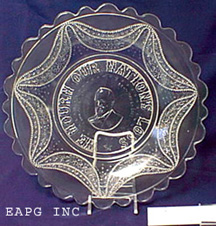 Memorial Portrait Plate for President Garfield. |
|
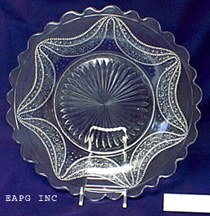 Identical plate as above but with star center instead of Memorial |
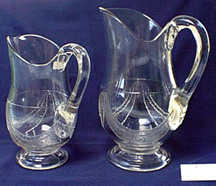 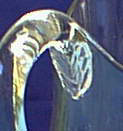 The milk pitcher and water pitcher with applied
handles featuring the "Burlington" or Chevron mark (at right)
on the top of the handle. |
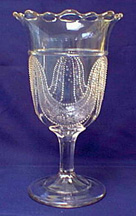 Tall Pedestaled Celery Vase |
|
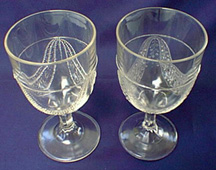 |
Three of the several forms of goblets
known to exist. The 2 on the left are "Gentleman's" size,
one of which has a drape w/ very small beads and a heavily imprinted
spray between the drapes and one which has large beads lining the drapes
and a very light strike of the spray (see photo at right for the different
pattern elements). The 3rd goblet in the photo on the left is the rare "Ladies" size
with a pattern similar to the goblet next to it. |
|
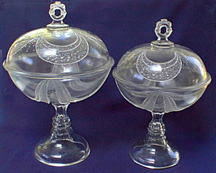 |
At left are the 7" and the 8" diameter
high standard covered compotes. Both have the plain base and a wafer
connection between the base and the bowl. |
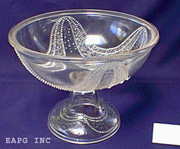 |
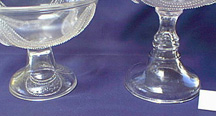 |
| The open low standard compote in the photo on the left has a wafer connection and the pattern motif on the base as well as on the bowl. The photo on the right shows the 2 different bases for the compotes. | |
 |
At Left are 3 of the 4" footed sauce dishes. |
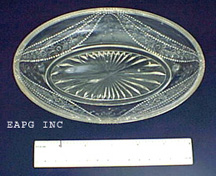 |
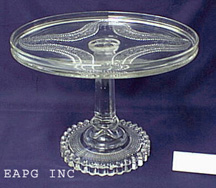 |
One of 3 oval relish/ pickle/ serving bowls identical
except in graduated sizes. |
The majestic and hard-to-find cake standwith an
icing rim. It has the wafer connection between the base and the plate. |
In the photo on the right, is the
four piece table set: cov'd sugar, spooner, creamer andthe very scarce
cov'd butter dish. The butter dish also comes with a footed base. |
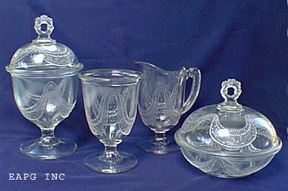 |
| Following are some of the personal conclusions
and speculations of Jon Clark of Canada who
has collected and studied Canadian glass extensively. Regarding the difference between "Garfield Drape" and "Canadian Drape", it is my opinion that the difference is in name only and that there is only one pattern. I recognize that there are a number of variations in some forms of the pattern and that several different molds were used in the manufacture of goblets. These variations have led some to conclude that there are two distinct patterns and that the pattern was manufactured by more than one maker. Maker and Dates. I will say that to the best of my knowledge, neither the manufacturer nor the period of manufacture has been established to today's standards of proof. (See Hal Hooper’s comments below.) I think that it is more likely that the full line of tableware was produced by a single manufacturer over a period of some years. This thought is supported by changes in style and manufacturing technique that are present in some forms of the pattern. It appears the pattern's manufacture was first attributed to Adams & Co. by Ruth Webb Lee in the 1931 edition of Early American Pressed Glass in which she wrote: "An old glassmaker long associated with the trade, asserted that this pattern was made by Adams & Co., of Pittsburgh." Revi subsequently provides us a history of Adams & Co in American Pressed Glass and Figure Bottles but does not make the attribution. Mrs. Kamm seems to openly disagree with Lee when she notes that Adams & Co. manufactured a commemorative mug, "But who made the Garfield table pattern has not been determined." (Kamm, I, 24.) While Ruth Webb Lee's original attribution of the pattern to Adam's & Co, may or may not prove to be correct, it appears to be the principal basis for the widespread and long held belief (repeated several times in print) that Adam's & Co. is the manufacturer. In 1968, John Sheeler published his conclusion that "Garfield Drape" was produced by the Burlington Glass Works, Hamilton, Ontario. Mr. Sheeler had reviewed the literature (and made reference to Lee and Revi cited above). He also participated in several archaeological digs at the site of the Burlington Glass Works at which a number of fragments of the "Garfield Drape" pattern were unearthed. His conclusions were published in the "Canadian Collector" in a six part article titled "The Burlington Glass Site" (Vol. 3, Nos. 4, 5,6,7,8, and 11). Several authors have concluded that we know exactly when the pattern was produced on the basis of the 11" Garfield Memorial Plate which was very likely produced very shortly after the death of the 20th President on September 19, 1881. I personally suspect that the pattern was first produced in the mid to late 1870's and probably continued in production for some time after 1881. I theorize that the Memorial Plate was an both opportunity to sell the plate and to increase the popularity of an extensive existing pattern line. There are differences in the water pitchers with the chevron impress ("Burlington mark") and differences in goblets. I have three different goblets in the pattern. In addition to slight variations in pattern, they differ in stems and the ring above the pattern (resulting from how the rim was pressed - and definitely beyond the scope of this note). Creamers were made in bulbous form with applied handles and were later entirely pressed. The milk and water pitchers occur with both types of applied handle. The earlier, top down strap handle and the later, when a large "blob" of glass was first attached at the bottom. Both handle types appear both with and without the chevron impress. Following are contributions about this pattern by Hal Hooper. It would appear from a photo in an early catalog which shows goblets and a waste bowl in the Garfield Drape pattern on a Transcontinental Railroad water tray, that the "Railroad" tray was made by the same company that made "Garfield Drape". It would also certainly appear that the "Railroad" tray was made by the same company that made "Dahlia"....... as they have the same type nomenclature and design on their handles. The "Dahlia", "Flower Pot", and the "Railroad" plates are all shown together in the same jobber's catalog in Figure 21 of Spillman’s article on Adam’s Glass Co. to see click HERE. The captions in Figure 22 note that this is Assortment No. 135 and there are 12 Fancy Trays that are packed with 12 Slop (waste) Bowls, 12 1-quart Pitchers and 24 Goblets. Further it says that this is the only complete Water Set ever offered at this price. So the fancy railroad trays are part of this water set. As for the attribution, in the Figures 19, 20, 21, and 22, there are two patterns that have been identified as to the maker. The first is "Rose in the Snow" and that has been attributed to Bryce Brothers. The second is "Sheraton" which is actually shown in some ads that it was made by Bryce Higbee. In looking through the Bryce Higbee book, they did not appear to make any vaseline pieces and even made reference in a couple of spots that the usual Bryce Higbee colors were Blue and Amber. Since the Bryce Higbee company was started by one of the original Bryce Brothers, they shared a few patterns, "Spirea Band" is one of them. The book gives a list of the patterns that the authors have attributed to Bryce Brothers as well as Bryce Higbee. "Spirea Band" is one. "Sheraton" was not listed under the Bryce Brothers patterns, but when I polled the vaseline list for anyone who might have a "Sheraton" piece in vaseline, Steve Sandeman came up with milk pitcher. Then, I deduced that "Sheraton" was also made by Bryce Brothers because it came in vaseline. The conclusive attribution, of Garfield Drape, alas, is still unproven. |
 |
 |
 |